A Reference Model Assisted Adaptive Control Structure for Maglev Transportation System
Abstract
1. Introduction
- a nonlinear reference model for the MLS inspired from the adaptive framework for the aerospace and type-1 diabetic patients in References [32,33,34,35], to deal with higher-order uncertain dynamics (electromagnetic force) in terms of model parameters (e.g., coil resistance, coil inductance, magnetic constant, etc.),
- the adaptive laws (control law and parameter update laws) are obtained without a cost function,
- sudden change or fault in the matched and mismatched uncertainties, up to are compensated online,
2. Problem Formulation
2.1. Problem Statements
- The nonlinear and uncertain dynamics of mechanical and electrical subsystems areThe coil inductance is presented as a function of the ball position using different approximations. is an incremental inductance due to the ball at , a is a length constant, and and are mathematical constants. Some of the widely used approximations are described in Table 2.
- Using the Wong approximation for the mechanical sub-system, neglecting the coupling inductance, and considering the constant self-inductance () for the electrical sub-system, the nominal mathematical model of MLS is expressed aswhere are the operating constant parameters of MLS, is the adaptive coil voltage that is to be developed by an adaptive control structure, and , are the state variables that represent the steel ball position, vertical velocity, and coil current, respectively.
- The nominal algebraic equations for the parameters associated with the nonlinear model in Equation (5) are given asThese parameters are valid only around the operating conditions (i.e., , , , ) [41]. It is reported in Reference [42] that the MLS possesses a high level of parametric uncertainties. Variation in may cause sticking of the steel ball to the electromagnet or falling, and drift in or from the operating values may cause the burning of coil or actuator saturation.
2.2. Control Objectives
- The steel ball should stay within the safe bounds of m [1]. In this simulation study, m is considered. Hence, the ball must stay within 0.008–0.010 m under all circumstances.
- The electrical signals, like coil voltage and coil current, should not cross the upper safe limits of +24 V and +2.5 A, respectively, to avoid actuator saturation. The same signals must be maintained positive to avoid the falling of the steel ball, (i.e., ).
- The steel ball should stay within the safe limits specified earlier even during the sudden change in the matched (i.e., ) or mismatched (i.e., ) parameters.
3. Model-Assisted Adaptive Control Design
4. Results and Discussion
4.1. Design of Reference Model Stabilizer
4.2. Design of Parameter Adaptation Mechanism
5. Concluding Remarks
Author Contributions
Funding
Acknowledgments
Conflicts of Interest
References
- Lee, H.; Kim, K.; Lee, J. Review of Maglev Train Technologies. IEEE Trans. Magn. 2006, 42, 1917–1925. [Google Scholar]
- Kim, S.K. Nonlinear position stabilizing control with active damping injection technique for magnetic levitation systems. Electronics 2019, 8, 221. [Google Scholar] [CrossRef]
- Zhang, W.; Wei, W.; Yang, Y.; Nan, N. An Operation Control Strategy for the Connected Maglev Trains Based on Vehicle-Borne Battery Condition Monitoring. Wirel. Commun. Mob. Comput. 2018, 2018, 1–10. [Google Scholar] [CrossRef]
- Zhang, Z.; Li, X. Real-Time Adaptive Control of a Magnetic Levitation System with a Large Range of Load Disturbance. Sensors 2018, 18, 1512. [Google Scholar] [CrossRef]
- Sinha, P.K. Dynamics of magnetically suspended vehicles. Trans. Inst. Meas. Control 1979, 1, 57–64. [Google Scholar] [CrossRef]
- Liu, Z.; Long, Z.; Li, X. Maglev Trains Key Underlying Technologies; Springer Tracts in Mechanical Engineering: Berlin/Heidelberg, Germany, 2015; pp. 1–224. [Google Scholar]
- Amrhein, W.; Gruber, W.; Bauer, W.; Reisinger, M. Magnetic Levitation Systems for Cost-Sensitive Applications — Some Design Aspects. IEEE Trans. Fuzzy Syst. 2016, 52, 3739–3752. [Google Scholar] [CrossRef]
- Yaghoubi, H. The most important Maglev applications. J. Eng. 2013, 2013, 1–19. [Google Scholar] [CrossRef]
- Park, Y. Design and implementation of an electromagnetic levitation system for active magnetic bearing wheels. IET Control Theory Appl. 2014, 8, 139–148. [Google Scholar] [CrossRef]
- Banerjee, S.; Pal, J.; Prasad, D. Performance study of the controller of an attraction type levitation system under parametric change. J. Electr. Syst. 2010, 3, 377–394. [Google Scholar]
- Ghosh, A.; Krishnan, T.R.; Tejaswy, P.; Mandal, A.; Pradhan, J.; Ranasingh, S. Design and implementation of a 2-DOF PID compensation for magnetic levitation systems. ISA Trans. 2014, 53, 1216–1222. [Google Scholar] [CrossRef]
- Gandhi, R.; Adhyaru, D. Hybrid intelligent controller design for an unstable electromagnetic levitation system: A fuzzy interpolative controller approach. Int. J. Control Autom. 2019, 13, 735–754. [Google Scholar] [CrossRef]
- Folea, S.; Muresan, C.; De Keyser, R.; Ionescu, C. Theoretical Analysis and Experimental Validation of a Simplified Fractional Order Controller for a Magnetic Levitation System. IEEE Trans. Control Syst. Technol. 2016, 24, 756–763. [Google Scholar] [CrossRef]
- Wai, R.J.; Lee, J.D.; Chuang, K.L. Real-time PID control strategy for maglev transportation system via particle swarm optimization. IEEE Trans. Ind. Electron. 2011, 58, 629–646. [Google Scholar] [CrossRef]
- Yang, Z.J.; Miyazaki, K.; Kanae, S.; Wada, K. Robust Position Control of a Magnetic Levitation System via Dynamic Surface Control Technique. IEEE Trans. Ind. Electron. 2004, 51, 26–34. [Google Scholar] [CrossRef]
- Kai, C.Y.; Huang, A.C. Adaptive control of magnetic levitation system subject to external disturbances. J. Chin. Inst. Eng. 2016, 39, 513–520. [Google Scholar] [CrossRef]
- Bidikli, B.; Bayrak, A. A self-tuning robust full-state feedback control design for the magnetic levitation system. Control Eng. Pract. 2018, 78, 175–185. [Google Scholar] [CrossRef]
- Xu, J. Adaptive robust constrained state control for non-linear maglev vehicle with guaranteed bounded airgap. IET Control Theory Appl. 2018, 12, 1573–1583. [Google Scholar] [CrossRef]
- Eroǧlu, Y.; Ablay, G. Cascade sliding mode-based robust tracking control of a magnetic levitation system. Proc. Inst. Mech. Eng. Part I J. Syst. Control Eng. 2016, 230, 851–860. [Google Scholar] [CrossRef]
- Gandhi, R.; Adhyaru, D. Takagi-Sugeno Fuzzy Regulator Design for Nonlinear and Unstable Systems using Negative Absolute Eigenvalue Approach. IEEE J. Autom. Sin. 2020, 7, 1–14. [Google Scholar] [CrossRef]
- Joo, S.; Seo, J. Design and analysis of the nonlinear feedback linearizing control for an electromagnetic suspension system. IEEE Trans. Control Syst. Technol. 1997, 5, 135–144. [Google Scholar]
- Barie, W.; Chaisson, J. Linear and nonlinear state-space controllers for magnetic levitation. Int. J. Syst. Sci. 1996, 27, 1153–1163. [Google Scholar] [CrossRef]
- Zhang, L. Hybrid non-linear differentiator design for a permanent-electro magnetic suspension maglev system. IET Signal Process. 2012, 6, 559–567. [Google Scholar] [CrossRef]
- Back, J. Reduced-order implementation of disturbance observers for robust tracking of non-linear systems. IET Control Theory Appl. 2014, 8, 1940–1948. [Google Scholar] [CrossRef]
- Chen, X.; Li, J.; Yang, J.; Li, S. A disturbance observer enhanced composite cascade control with experimental studies. Int. J. Control. Autom. Syst. 2013, 11, 555–562. [Google Scholar] [CrossRef]
- Zhou, W.; Liu, B. Backstepping Based Adaptive Control of Magnetic Levitation System. Appl. Mech. Mater. 2013, 342, 945–948. [Google Scholar] [CrossRef]
- Lin, F.J.; Teng, L.T.; Shieh, P.H. Intelligent adaptive backstepping control system for magnetic levitation apparatus. IEEE Trans. Magn. 2007, 43, 2009–2018. [Google Scholar] [CrossRef]
- Zhai, M.; Long, Z.; Li, X. A new strategy for improving the tracking performance of magnetic levitation system in maglev train. Symmetry 2019, 11, 1053. [Google Scholar] [CrossRef]
- Adıgüzel, F.; Dokumacılar, E.; Akbatı, O.; Türker, T. Design and implementation of an adaptive backstepping controller for a magnetic levitation system. Trans. Inst. Meas. Control 2018, 40, 2466–2475. [Google Scholar] [CrossRef]
- Al-Araji, A.S. Cognitive non-linear controller design for magnetic levitation system. Trans. Inst. Meas. Control 2016, 38, 215–222. [Google Scholar] [CrossRef]
- Radac, M.; Precup, R.; Hedrea, E.; Tănăsoiu, O. Gain-Scheduling Control Solutions for Magnetic Levitation Systems. Acta Polytech. Hung. 2018, 15, 89–108. [Google Scholar]
- Deb, D.; Tao, G.; Smith, D.R. Adaptive Compensation Control of Synthetic Jet Actuator Arrays for Airfoil Virtual Shaping. J. Aircr. 2007, 44, 616–626. [Google Scholar] [CrossRef]
- Deb, D.; Tao, G.; Burkholder, J.O.; Smith, D.R. Adaptive Synthetic Jet Actuator Compensation for A Nonlinear Aircraft Model at Low Angles of Attack. IEEE Trans. Control Syst. Technol. 2008, 16, 983–995. [Google Scholar] [CrossRef]
- Nath, A.; Deb, D.; Dey, R.; Das, S. Blood glucose regulation in type 1 diabetic patients: An adaptive parametric compensation control-based approach. IET Syst. Biol. 2018, 12, 219–225. [Google Scholar] [CrossRef] [PubMed]
- Nath, A.; Deb, D.; Dey, R. An augmented subcutaneous type 1 diabetic patient modelling and design of adaptive glucose control. J. Process Control 2020, 86, 94–105. [Google Scholar] [CrossRef]
- Jacob, E. Quanser Magnetic Levitation User Manual. Available online: file:///C:/Users/MDPI/AppData/Local/Temp/made-for-science-Quanser-magnetic-levitation-CoursewareStud-MATLAB.pdf (accessed on 12 October 2020).
- Wong, T.H. Design of a magnetic levitation control system undergraduate project. IEEE Trans. Educ. 1986, E-29, 196–200. [Google Scholar] [CrossRef]
- Woodson, H.; Melcher, J. Electromechanical Dynamics; John Wiley & Sons: Sydney, Australia, 1968; pp. 1–414. [Google Scholar]
- Hurley, W.; Wölfle, W. Electromagnetic design of a magnetic suspension system. IEEE Trans. Educ. 1997, 40, 124–130. [Google Scholar] [CrossRef]
- Gandhi, R.; Adhyaru, D. Novel approximation-based dynamical modelling and nonlinear control of electromagnetic levitation system. Int. J. Comput. Syst. Eng. 2018, 4, 224–237. [Google Scholar] [CrossRef]
- Wei, W.; Xue, W.; Li, D. On disturbance rejection in magnetic levitation. Control Eng. Pract. 2019, 82, 24–35. [Google Scholar] [CrossRef]
- Banerjee, S.; Prasad, D.; Pal, J. Large gap control in electromagnetic levitation. ISA Trans. 2006, 45, 215–224. [Google Scholar] [CrossRef]
- Goodall, R. Dynamic characteristics in the design of MAGLEV suspensions. J. Rail Rapid Transitinst. Mech. Eng. 1994, 208, 33–41. [Google Scholar] [CrossRef]
- Godbole, A.A.; Kolhe, J.P.; Talole, S.E. Performance Analysis of Generalized Extended State Observer in Tackling Sinusoidal Disturbances. IEEE Trans. Control Syst. Technol. 2013, 21, 2212–2223. [Google Scholar] [CrossRef]
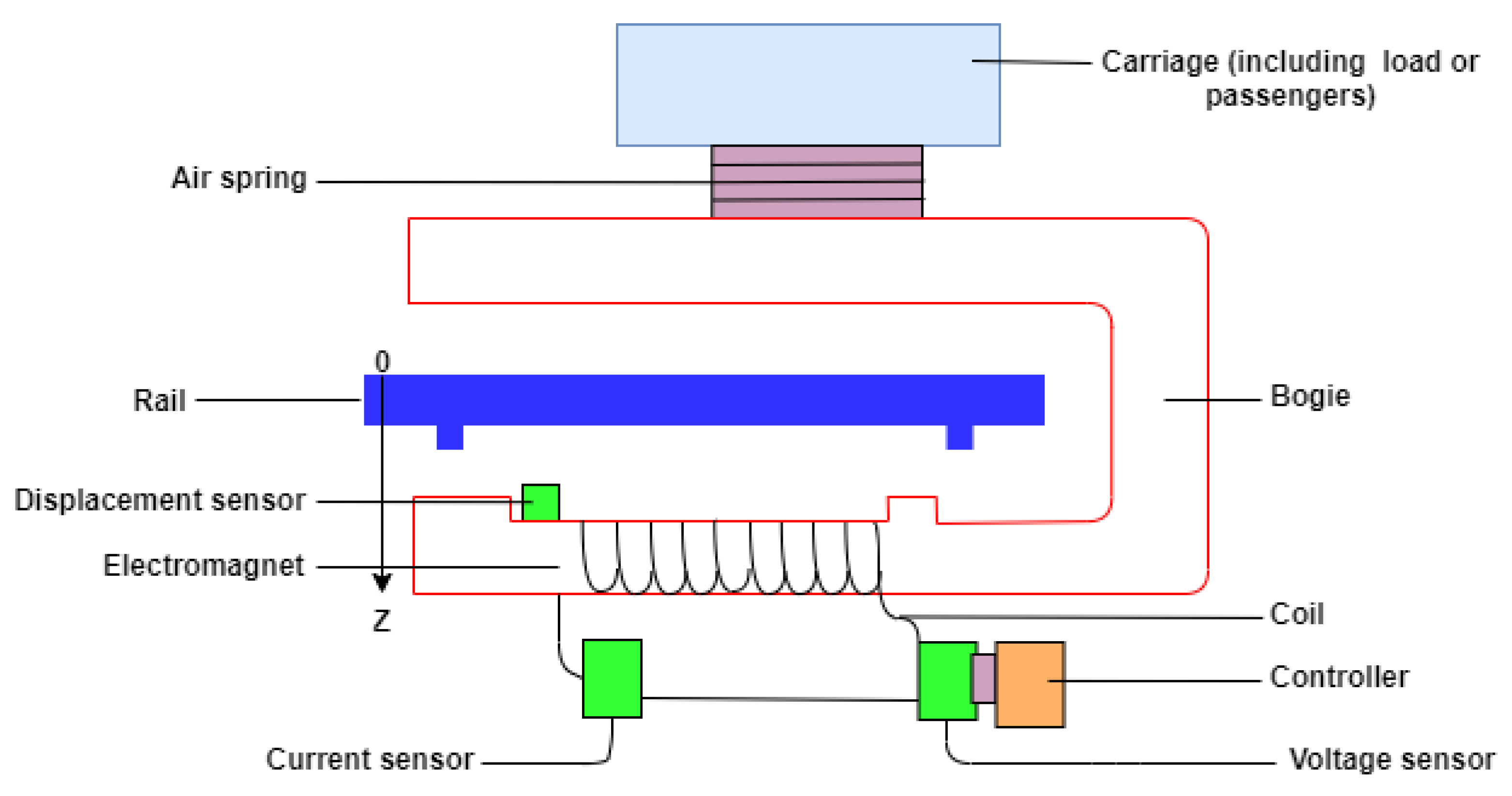
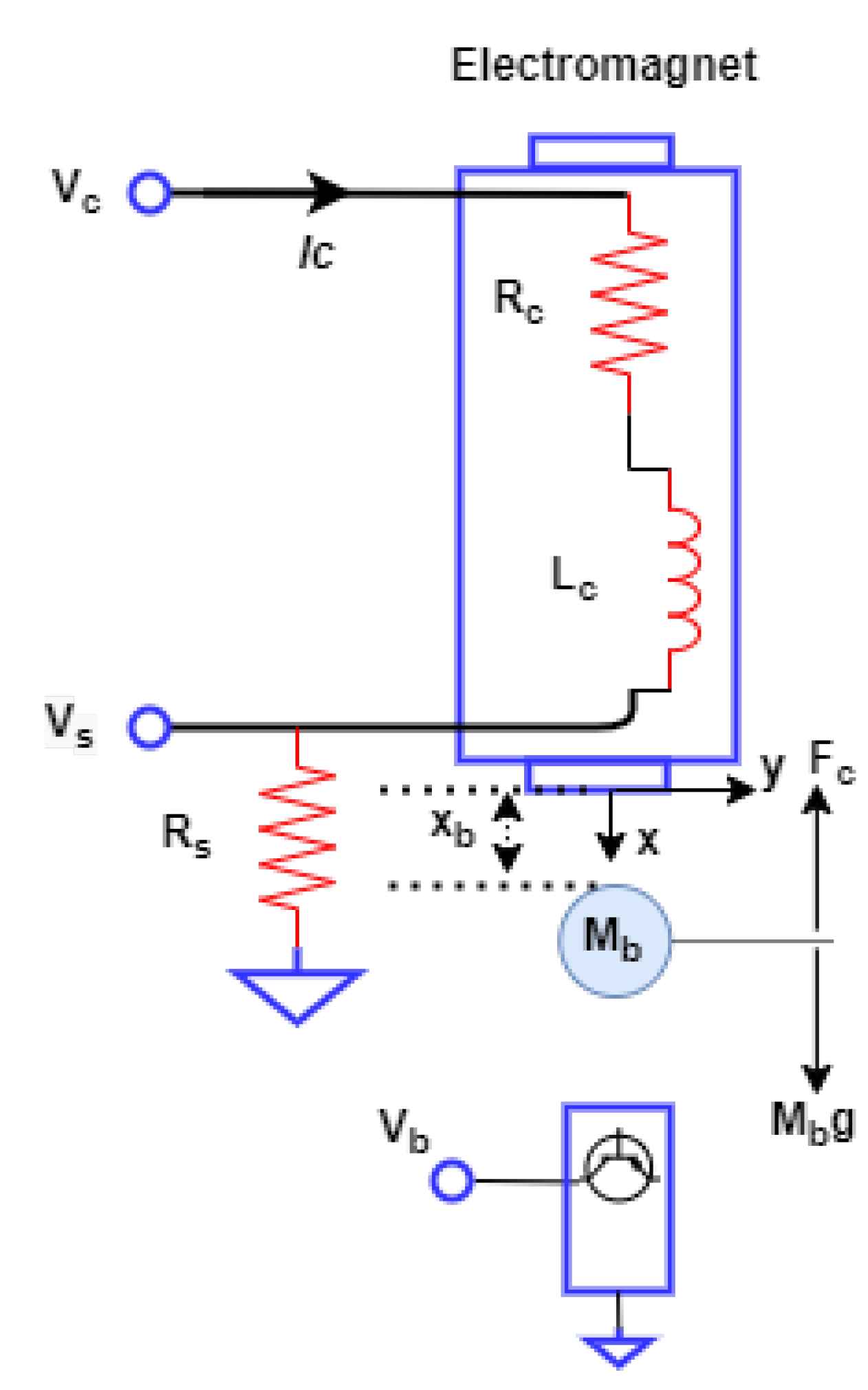

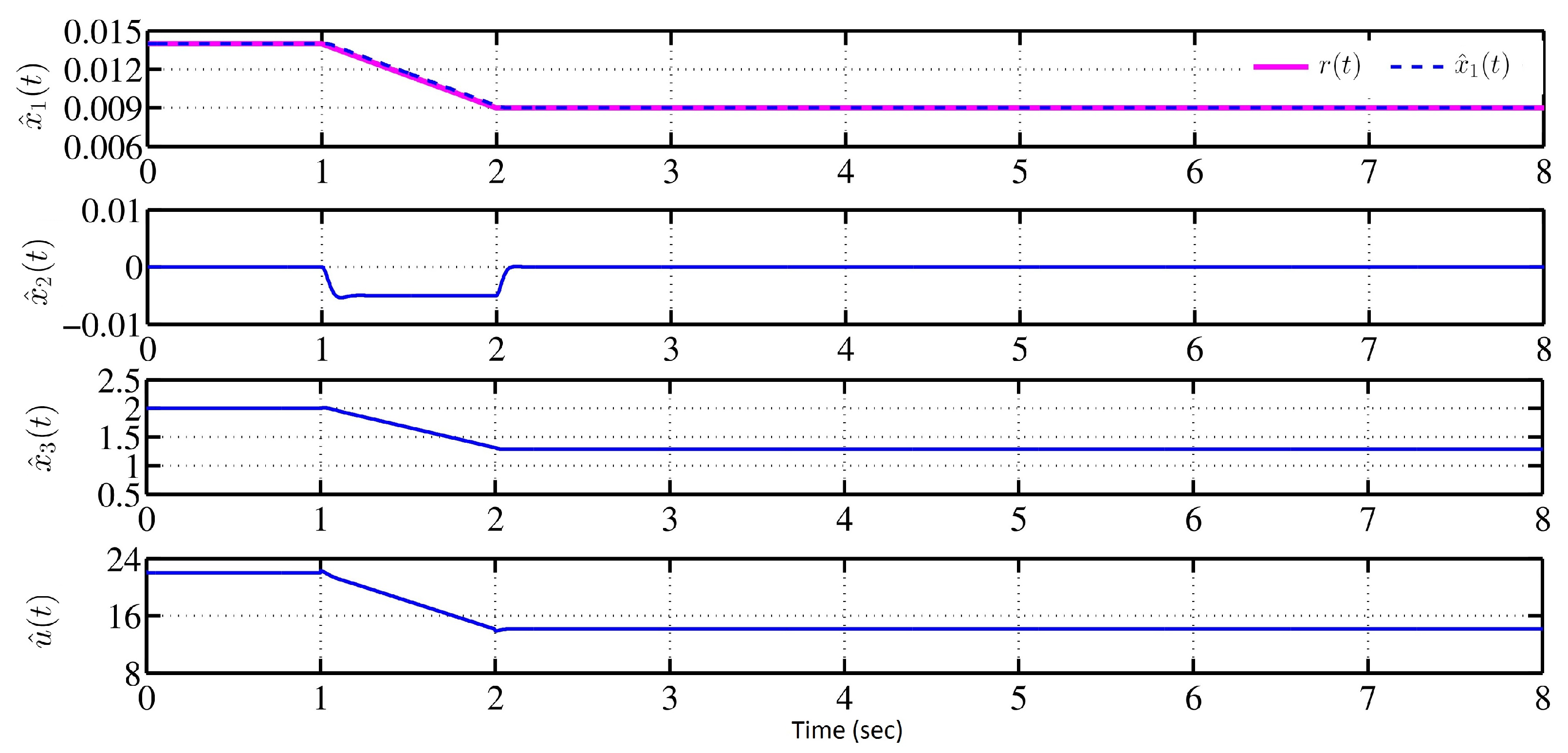
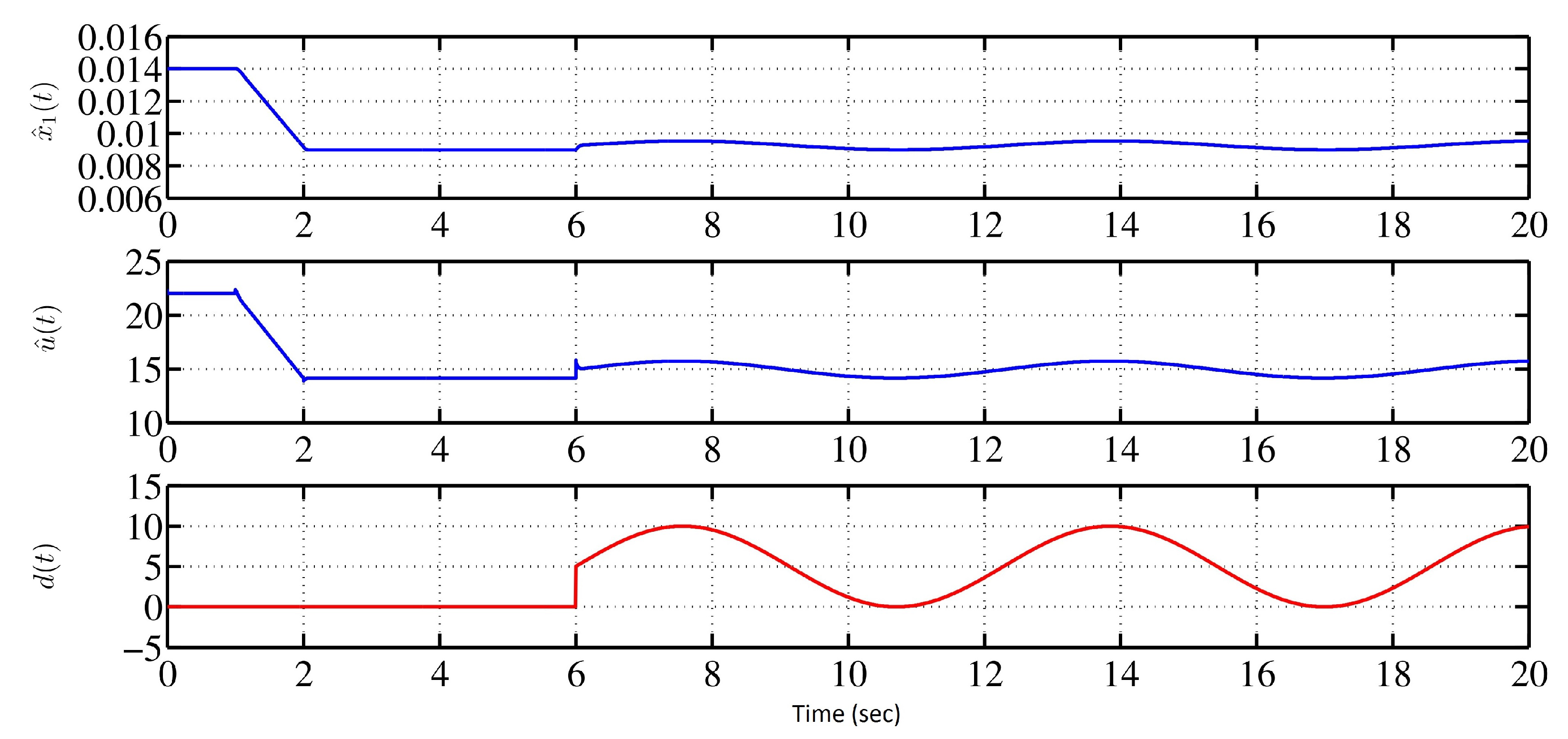

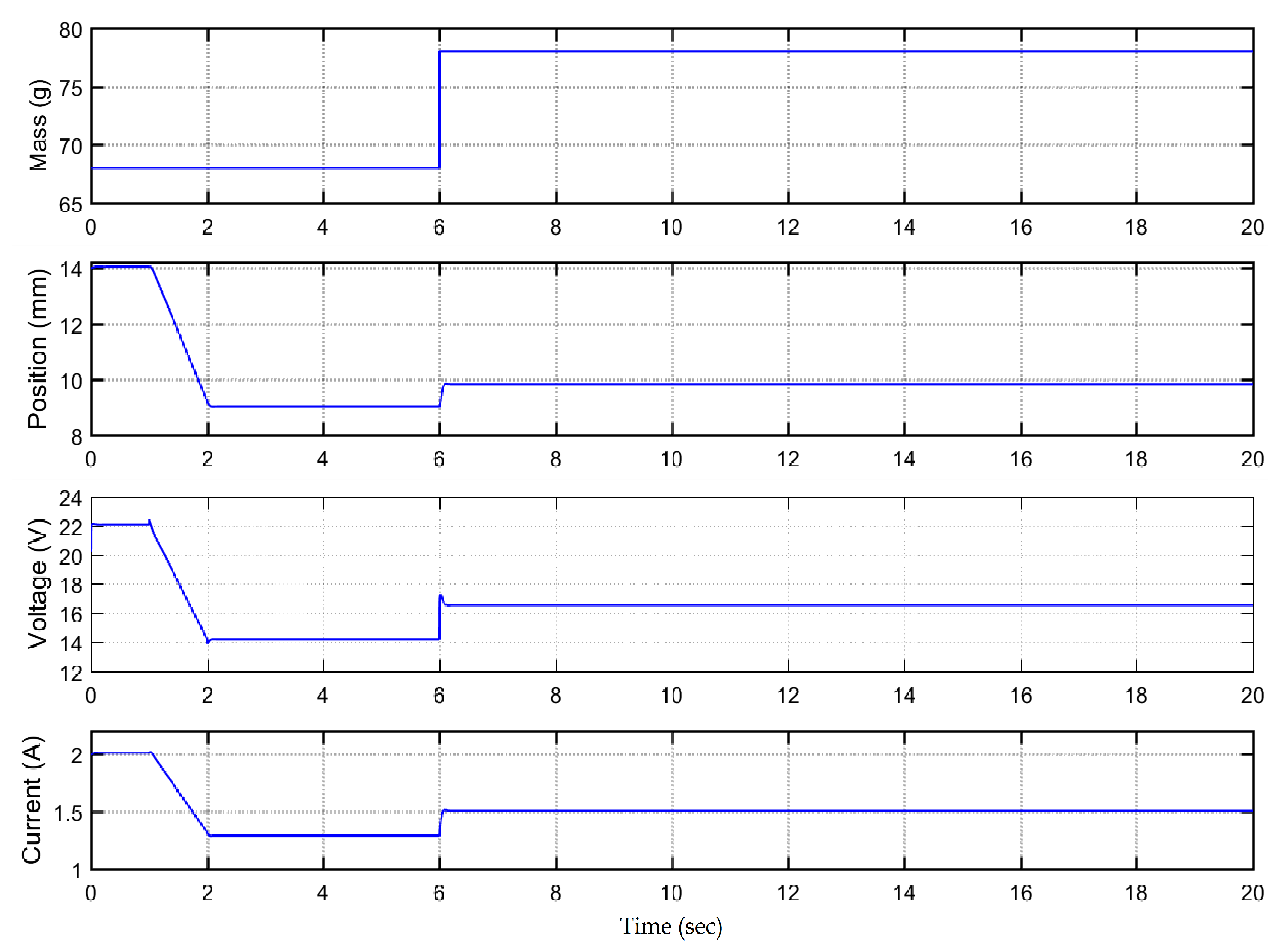
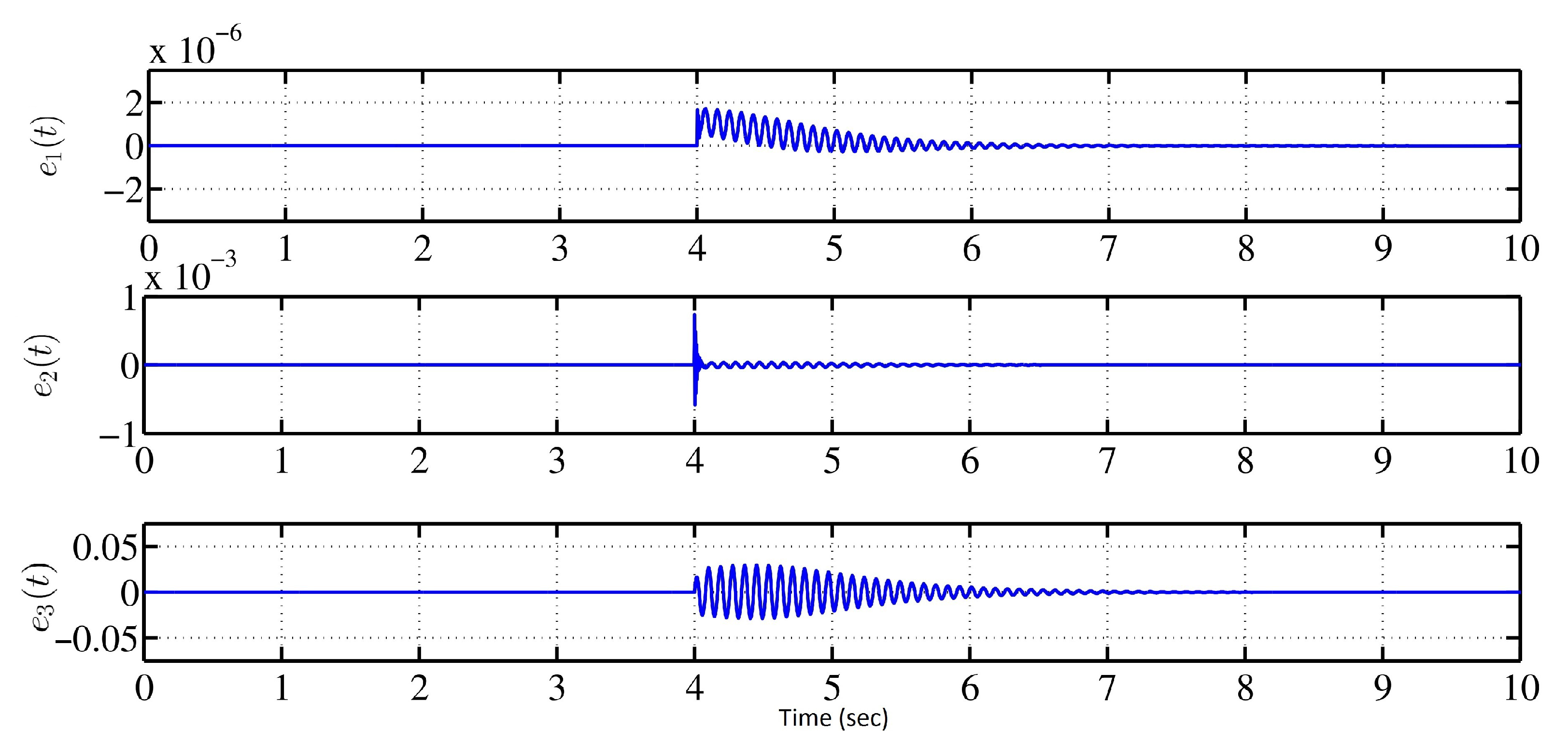


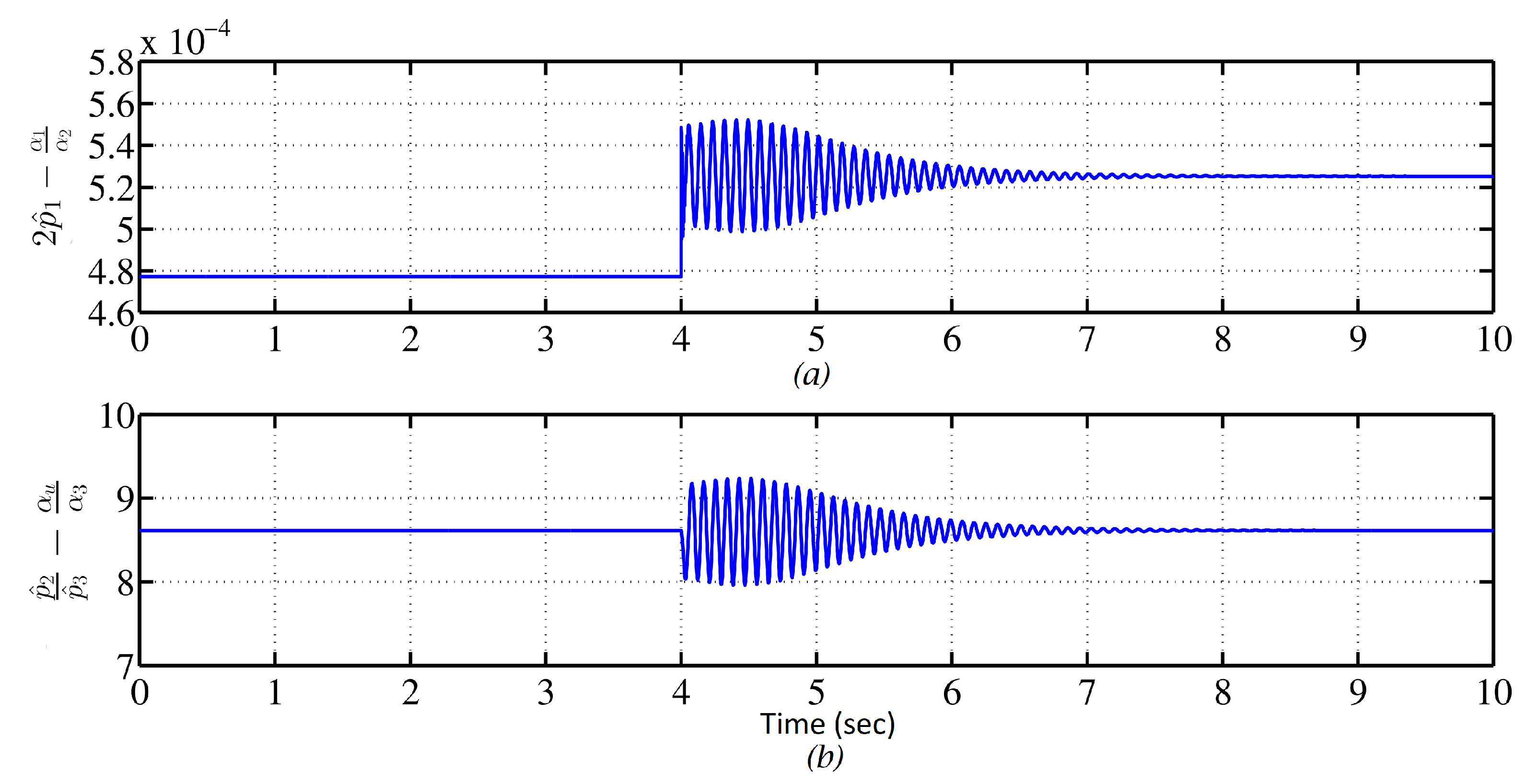
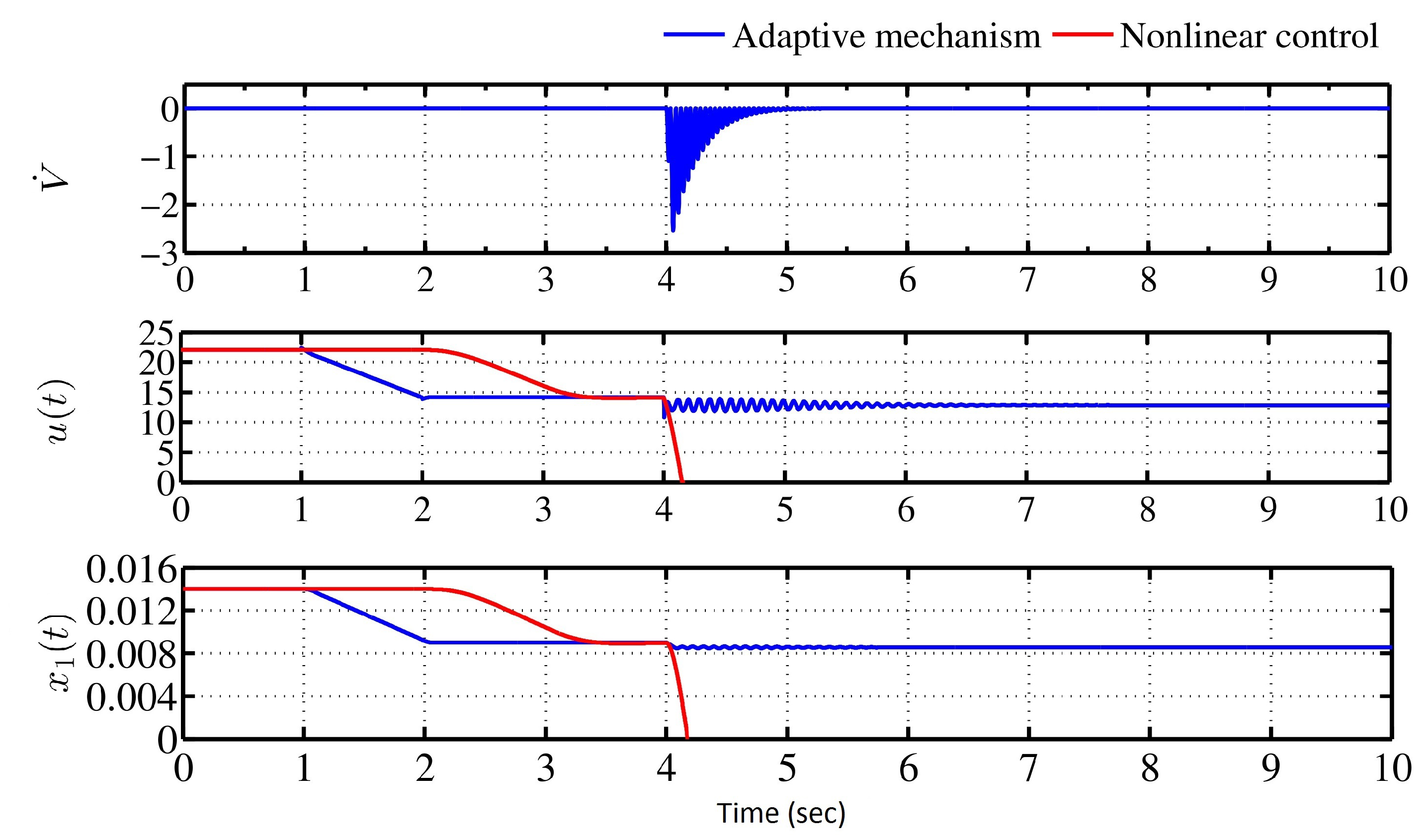
| Parameter | Symbol | Value | Unit |
|---|---|---|---|
| Coil resistance | |||
| Current sensor resistance | 1 | ||
| Ball mass | Kg | ||
| Electromagnetic constant | H/m | ||
| Gravitational constant | g | 9.81 | m/s |
| Sr. No | Approximation | Formula () |
|---|---|---|
| 1 | Wong [37] | |
| 2 | Woodson [38] | |
| 3 | Hurley [39] | |
| 4 | Gandhi [40] |
| Parameter | Nominal Value | Bounds |
|---|---|---|
| [17.33, 36] | ||
| 2.4242 | [1.5757, 3.2727] | |
| - | ||
| - | ||
| - | ||
| - |
| Parameter | Value | Parameter | Value |
|---|---|---|---|
| 2.1 | |||
| - | - |
Publisher’s Note: MDPI stays neutral with regard to jurisdictional claims in published maps and institutional affiliations. |
© 2021 by the authors. Licensee MDPI, Basel, Switzerland. This article is an open access article distributed under the terms and conditions of the Creative Commons Attribution (CC BY) license (http://creativecommons.org/licenses/by/4.0/).
Share and Cite
Dalwadi, N.; Deb, D.; Muyeen, S.M. A Reference Model Assisted Adaptive Control Structure for Maglev Transportation System. Electronics 2021, 10, 332. https://doi.org/10.3390/electronics10030332
Dalwadi N, Deb D, Muyeen SM. A Reference Model Assisted Adaptive Control Structure for Maglev Transportation System. Electronics. 2021; 10(3):332. https://doi.org/10.3390/electronics10030332
Chicago/Turabian StyleDalwadi, Nihal, Dipankar Deb, and S. M. Muyeen. 2021. "A Reference Model Assisted Adaptive Control Structure for Maglev Transportation System" Electronics 10, no. 3: 332. https://doi.org/10.3390/electronics10030332
APA StyleDalwadi, N., Deb, D., & Muyeen, S. M. (2021). A Reference Model Assisted Adaptive Control Structure for Maglev Transportation System. Electronics, 10(3), 332. https://doi.org/10.3390/electronics10030332








